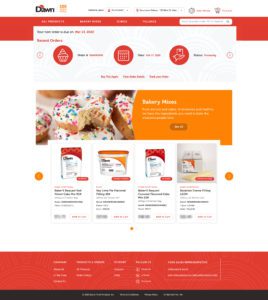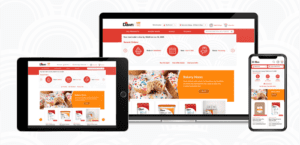Like any master baker knows, the secret to making irresistible food is in the right mix of ingredients and the way they blend together in the oven. For Dawn Food Products Inc., using a form of that strategy in the realm of digital commerce technology helped it lure customers into the benefits of ordering online.

Bob Howland, chief digital officer, Dawn Foods Global
“We wanted to build something by bakers and for bakers, and build it in a way with ultimate flexibility,” says Bob Howland, chief digital officer, Dawn Foods Global.
It took some work and tweaks of the technology recipe, but in an industry that wasn’t known for forging ahead with digital commerce, it wasn’t long before Dawn saw results.
“Until you change the system, you don’t know if change will be received well or not,” says Howland, who is a veteran of other B2B and technology organizations including Affiliated Distributors, Global Sports International (also known as GSI) and Blueport Commerce. Howland joined Dawn as the chief digital officer early last year to establish the company’s technology innovation hub and its goal of bringing both the company and the broader bakery industry further into digital commerce.
After running a test pilot of its new ecommerce site last year with bakery industry customers, Dawn basked in the realization that it had cooked up a winner. “Customers embraced it with open arms and said, ‘What took you so long?’” Howland says.
Learning—quickly—what customers want
Still, it wasn’t magic or luck that won over customers, who right away liked the new flexibility they now had to find and order at any time exactly what they needed—whether a 50-lb. bag of flour or a wide range of foodstuffs with detailed specifications spelling out hundreds of food product attributes like fat and gluten levels, Howland says.

A customer’s personalized order page displays various types of information on Dawn’s B2B ecommerce site.
In fact, Dawn Foods realized it had to quickly learn what customers wanted—and just as quickly make it easily available online to customers who were accustomed to the high-touch personal service of visiting sales reps.
“The level of information that they wanted was almost unlimited,” Howland says, adding, “Customers said ‘you need to figure out a way to put that information in front of us.’”

Gireesh Sahukar, senior director of digital technology, Dawn Foods
And when the COVID-19 pandemic hit this year, Dawn realized that its new platform—and Dawn’s ability to quickly modify it to meet customer needs—was even more important as customers needed a strong online option for ordering bakery supplies and equipment. “Bakeries have felt the heat—literally—from trying to simplify processes while working long hours in 80+ degree kitchens and focusing on business resiliency during the pandemic,” says Gireesh Sahukar, senior director of digital technology, Dawn Foods.
Good thing the digital innovation team had drawn up a blueprint for ecommerce based on a highly flexible technology ecosystem steeped in APIs and microservices designed in a “headless” commerce infrastructure, Howland says.
A system backed by APIs and microservices
Dawn’s ecommere infrastructure’s ecosystem includes a commercetools ecommerce engine designed with APIs and microservices to integrate with numerous other systems: a product information management, or PIM, system from Salisfy; a content management system for the customer-facing interface from Contentstack; and the use of GraphQL as a data query tool for managing the flow of product information. Dawn also worked with customer experience design and consulting firm EPAM Systems.
 To meet today’s demands in B2B commerce, technology platforms must provide automation among multiple applications and functionality that delivers value to both buyers and sellers, enabling manufacturers and distributors to “satisfy their customers’ insatiable demand for speed and choice while balancing profitability,” says Liz Herbert, a vice president and principal analyst at Forrester Research Inc. covering enterprise technology.
To meet today’s demands in B2B commerce, technology platforms must provide automation among multiple applications and functionality that delivers value to both buyers and sellers, enabling manufacturers and distributors to “satisfy their customers’ insatiable demand for speed and choice while balancing profitability,” says Liz Herbert, a vice president and principal analyst at Forrester Research Inc. covering enterprise technology.
Using applications of such technologies as artificial intelligence, machine learning and the internet-of-things, well-designed digital platforms can help B2B sellers better match their production capabilities and financial goals with customer demand. This not only helps to maintain optimal inventory flow and profit margins while satisfying customers’ wants and needs, but it can also help sellers more quickly and easily adjust to sudden market fluctuations caused by unexpected market disruptions, including 2020’s COVID-19 pandemic.
How Dawn addressed customers’ needs
For Dawn Foods, the capabilities of its new platform and ecosystem proved to be of high value early on, Howland says. Within a month after launching its new platform in June 2020, as it quickly learned more about how customers wanted to use the site, Howland’s team made 40 updates to the customer-facing front-end interface.
Its ability to quickly update technology to address customer needs underscored why it chose a composable and headless technology environment that enabled Dawn to modify its customer-facing interface without also having to update software code in its commerce engine, Howland says.

Dawn’s online tablet, desktop and mobile device interfaces.
Content managers at Dawn Foods are able to use the headless platform daily for “updating existing content, publishing new content, removing out-of-date content and making other site changes on the fly without intervention from the development team,” Dawn says.
To figure out how it could best modify the site to further help customers in their everyday chores, Dawn relied on its pilot and gained information about its customers in three major areas:
- It learned that they were definitely ready and wanting to participate in the new ecommerce platform. “We wanted to ensure customers would embrace online ordering,” Howland says, adding, “They said ‘We’re excited you guys are bringing this forward to be a leader in the digital world.’”
- “We also learned that the level of online information they wanted was almost unlimited. They did not just want to know we could sell them a 50-lb. bag of flour, but they wanted to know everything about products like fat levels and gluten and more than 100 attributes.”
- Customers have many different ways of ordering products, and Dawn realized it had to learn more about these ordering methods and accommodate them.
“Making changes quickly to the website is aided by the library of APIs from commercetools, which also support the ability of Dawn and other companies to build such features as voice-based ordering,” says Kelly Goetsch, chief product officer for commercetools.
The flexibility of Dawn’s ecommerce platform played a big role in how the company was able to meet these needs to provide more product information and accommodate more ways of ordering.
To start out, Dawn designed the site to give online buyers the ability to place orders with a single click without having to enter shipping or billing information. Built with microservices, or custom applications that provide special features on ecommerce sites, its new ecommerce site provides the single-click buying and other services on smartphones, tablets and desktop devices.
Shopping lists designed for bakers
One thing Dawn quickly learned that bakers wanted was to have an online shopping list they could update as they worked around the kitchen and realized what they needed to order. “Many bakers make a list on a napkin, then come back when ready to place an order,” Howland says. “But they shared specific thoughts on how to bring that process to the online world.”
As customers were able to view and use the new ecommerce site, they advised Dawn on what they’d like to see and do on specific website pages to build a more useful online shopping experience. “So now it allows people to move through the site and flag specific items,” Howland says.

Lemon cake from the Dawn Foods product line.
And as they build lists, customers can name them for the next planned order or build a list for a particular seasonal project like Halloween or Thanksgiving. “They can create multiple lists and put multiple lists into a cart,” Howland says. “That was a behavior customers identified upon using the site for a few weeks.”
Dawn’s new agile, composable ecommerce platform made it possible to design those shopping lists, he adds, as it enabled his Digital Innovation Team to build the technology integration required to share data among Dawn’s technology systems including its PIM and content management systems. “Creating shopping lists is a very discrete process,” Howland says. “If it was on a large legacy platform, it would be a four or five-month project.”
But with a platform designed with extensive APIs and microservices, he says, “we were able to turn a project around in two weeks.”
Despite the limitations and pressures imposed by the COVID-19 pandemic—when more people were working from home, spurring an already increasing demand for online ordering—Dawn was able to stick to its ecommerce platform project timeline, and actually finish ahead of time and under budget, Howland says.
Relying more on the convenience of ecommerce
Its customer base, meanwhile, was able to increase its reliance on ecommerce as a tool to help them survive and better compete during the pandemic.
“The pandemic for many bakers was one of the hardest times in their tenure; it changed how they think about their community, their craft,” Howland says. “They took the opportunity to think about what was the best business model for these times.”
For many, online ordering was playing a bigger role for small as well as large bakery customers. “One of the beauties of online is that customers can see all of our products, and we did bundles of sell sheets around the holidays,” Howland says. Dawn’s new ecommerce platform was particularly helpful to smaller bakeries, who were able to view more information and images online regarding new products and the trends in their industry.
Dawn also is addressing the needs of larger customers by showing them “the convenience factor” of using the site. “We want to accommodate whatever is a best practice for them,” Howland says.
Building in a punchout option
Many large customers, for example, may have proprietary lists of products or product formulations; for some, ordering from a public-facing ecommerce site may not be consistent with their procurement process. For such customers, the convenience factor may require developing a punchout feature from their company’s procurement and spending-management software system to punch out to Dawn’s online product catalog. “Having a digital catalog is table stakes for that process,” he adds.
Since the ecommerce site launch, more than 50% of Dawn’s artisanal bakery customers have registered as online buyers, and nearly all online orders include products that a customer hadn’t ordered before (through offline orders), Howland says.
“Every week we’re seeing registered customers buying the same products, plus one or two new ones,” he adds. “And once a customer places two or three orders online—then they are sold on the online channel, and then only place orders online.”
“That’s very exciting,” Howland says.
(This article is included in a special report, “Technology Roadmap for B2B Ecommerce” recently published by Digital Commerce 360.)
Sign up for a complimentary subscription to Digital Commerce 360 B2B News, published 4x/week, covering technology and business trends in the growing B2B ecommerce industry. Contact editor Paul Demery at [email protected] and follow him on Twitter @pdemery.
Follow us on LinkedIn and be the first to know when new Digital Commerce 360 B2B News content is published.
Favorite